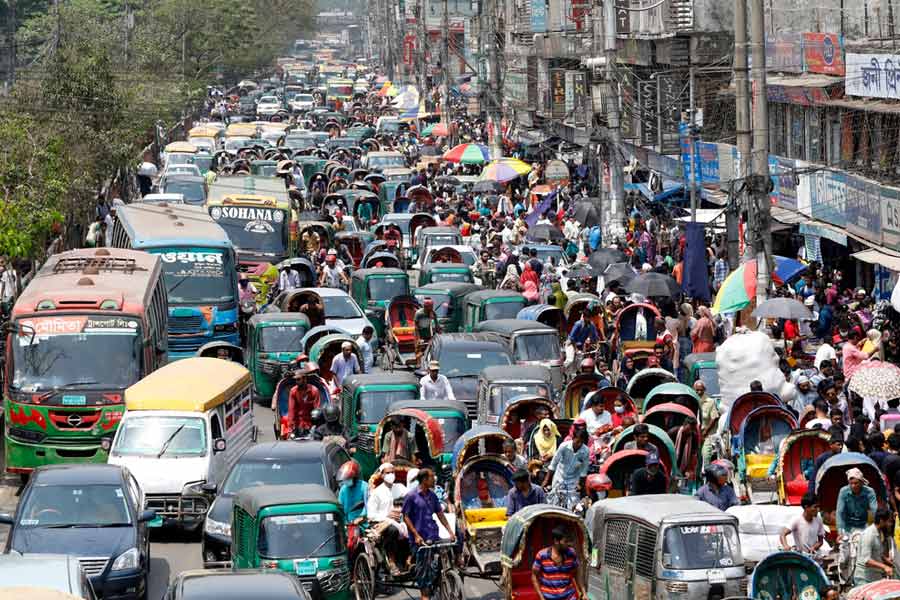Dhaka, the capital of Bangladesh is the slowest city in the world while the fastest city on the speed index is Flint in the US state of Michigan, according to a US-based private nonprofit research organisation's findings.
The study was done by the National Bureau of Economic Research (NBER) which covered 1,200 cities in 152 countries.
“The fastest city in the world is Flint (of Michigan) United States, with a speed index of 0.48. The slowest is Dhaka, Bangladesh, with an index of -0.60,” read the NERB report uploaded to their website.
The NERB said all cities in Bangladesh were among the slowest 15 per cent of world cities while it listed the central-north Mymensingh and the southeastern port city of Chottogram as the ninth and 12th slowest cities across the globe.
“Most strikingly, all cities with the fastest speed or uncongested speed are in rich countries, and all the slowest cities are in poor countries,” commented the report by Cambridge, Massachusetts-based NBER.
Researchers used data from Google Maps to analyse traffic in more than 1,000 global cities with populations over 300,000.
According to Google Maps, a 9-km trip from Dhaka’s Hazrat Shahjalal International Airport to Justice Shahabuddin Ahmed Park in the posh Gulshan area can take as long as 55 minutes.
The Bangladesh capital has been known for its notorious traffic jam for decades with experts largely blaming it on the lack of an effective public transport system in Dhaka, one of the largest megacities on the planet.
On the other hand, a trip of the same distance in Flint, Michigan, the world's fastest city, from the airport to the Sloan Museum of Discovery, takes about nine minutes, writes Time magazine in its report published on this particular study.
In 2020 Bangladesh University of Engineering and Technology (BUET) conducted a study and found the average speed of vehicles plying on Dhaka streets during peak hours was six and a half kilometers per hour.
The state-run university in a subsequent study in 2022 found the speed to have come down to about 4.8 km in 2022 while the average walking speed of physically fit people is more than that per hour.
According to BUET, Dhaka city traffic speed now dropped to 4.5 km per hour from 21 km a decade ago despite the government spending a staggering Taka 28,000 crore to ease the notorious traffic congestion.
The NERB report said two Nigerian cities Lagos and Ikorodu ranked second and third on their list, followed by Manila of the Philippines and Indian towns of Bhiwandi and Kolkata.
The NBER study concluded that there was a previously undocumented, first-order relationship between a country’s economic development and the speed of vehicular travel in its urban networks.
According to the NBER report the slowest cities, like Dhaka, Lagos, and Manila are almost all in the developing world where infrastructure hasn’t kept up with population”.
“(And) all cities with the fastest speed or uncongested speed are in rich countries, and all the slowest cities are in poor countries,” the authors write.
Lead author of the study, Bangladesh-born Prottoy Akbar, an economist at Aalto University in Finland and the lead author of the paper described the government's steps to ease Dhaka’s traffic situation could make little adjustments.
“That just means that you could, at best, make the speeds in the middle of the day look like speeds in the middle of the night . . . those sort of adjustments can only help so far,” Akbar said.
He said different cities needed different prescriptions to improve travel times. Even though accounting for just 6 per cent of the total population, car owners occupy up to 76 per cent of all road space in Dhaka, the capital could offer less than its 10 per cent space for road infrastructure.
Bangladesh authorities earlier this year opened a portion of the country’s first metro rail system, MRT-6, in the heart of Dhaka while the system is expected to cover the major areas including the business districts in the capital next month.
The South Asian country earlier this month also opened a major part of its first elevated express highway connecting major city points and expects to complete the next phase by 2024 while both infrastructures are expected to ease travel miseries of the people in the city.
Except for the headline, this story has not been edited by The Telegraph Online staff and has been published from a syndicated feed.











